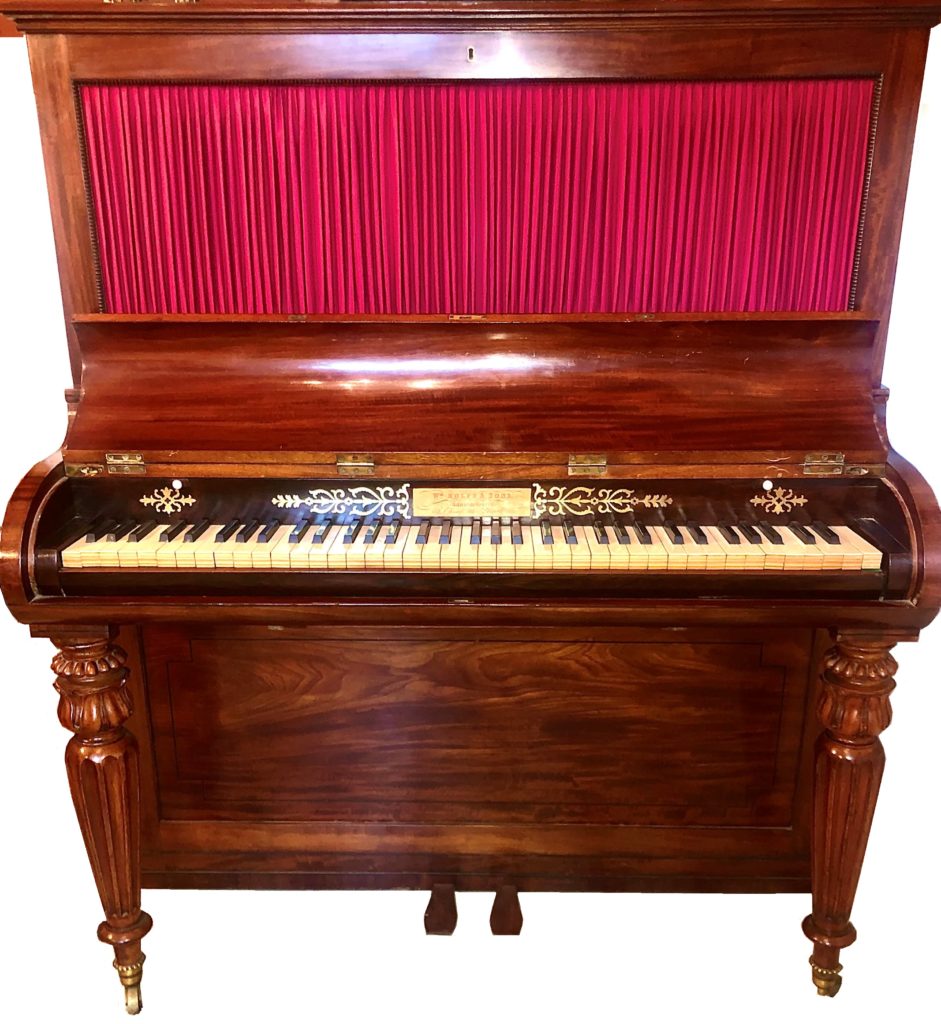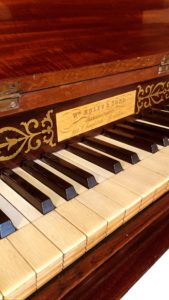Cottage Piano William Rolfe and Sons 1835
Description

| Date: | 1835 |
| Origin: | London |
| Serialnumber: | 1656 |
This elegant cottage piano by William Rolfe & Sons was manufactured in London in 1835 and shows the space-saving version of the square or grand piano at that time.
The case is made of solid mahogany with very fine inlays and the front is decorated with red silk. The keyboard is made of ivory and ebony. At both ends of the keyboard are two retractable platforms for candle holders that can be pulled out via a small ivory button. The instrument has two wooden pedals (dampers & una corda) and a compass of 6 octaves (FF – f4). The hammers are covered with felt and the instrument is double strung with an English Double Action and abstracts. The nameboard is decorated with various brass inlays and bears the signature:
„W. Rolfe & Sons
Manufacturers
112 Cheapside London”
The serial number 1656 appears on the right sight of the pin block. The music stand rests under the keyboard and can be hung into the cylindrical cover lid.
The instrument comes from the former collection of Mary and Kenneth Mobbs in Bristol. According to records, it was acquired from Rev. Gordon Robinson on April 7th, 1977. During the time in the possession of Mary and Kenneth Mobbs, the piano was loaned and exhibited at the Royal Academy of Music Museum.

Cottage Piano W. Rolfe & Sons, London 1835 – Eric Feller Collection (Nameboard)
William Rolfe worked as a piano maker from 1785 to about 1828. His exact dates of birth and death are not known yet. From 1785 he worked with Samuel Davis and the company was run under the name Rolfe & Davis. In 1797 both developed a patent for a “Turkish-Music-Stop” with cymbals and drums. According to R. Harding, this patent is the oldest testimony to such a change in the form of a janissary stop, which was very popular in the 1820s (especially by Viennese instruments) and then disappeared very quickly.
At the same time William Rolfe worked as an instrument maker and music publisher and was a partner of Thomas Culliford with whom he produced instruments for the company Longman & Broderip. He also sold his instruments under his name. After the bankruptcy of Longman & Broderip in 1796, he worked only under his name.
In 1807, his two sons Nicholas and Thomas became partners in the father’s company. From 1814, the company was renamed to William Rolfe & Sons and there were additional premises in the London Wall Street no. 32 added. The main address was since its founding in Cheapside 112. From about 1820 instruments were made under the name William Rolfe and Compy. The company existed until 1889.
Other surviving instruments by William Rolfe & Sons:
- 1820 – 1825 – Upright Piano – Private collection, Gates County USA
- 1814 – 1820 – Upright Piano – Museu da Musica Lisbon, Portugal
| Length: | 55,5 cm |
| Width: | 113,5 cm |
| Height: | 136 cm |
| Circumference: | 6 octaves (FF – f4) |
| Mechanics: | Double Action and abstracts |
| Pedals: | 2 pedals - dampers & una corda |
| Signature: |
„W. Rolfe & Sons Manufacturers 112 Cheapside London” |

